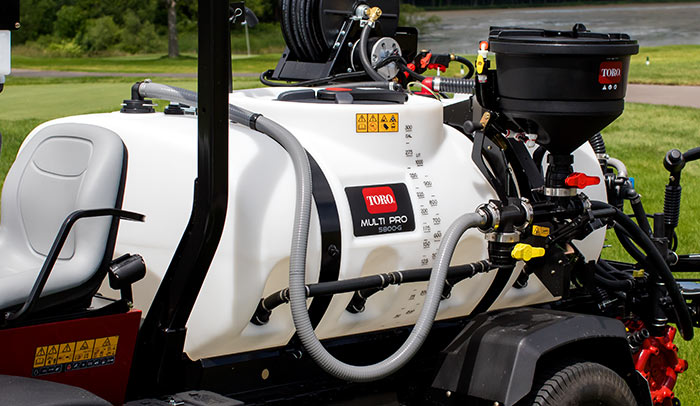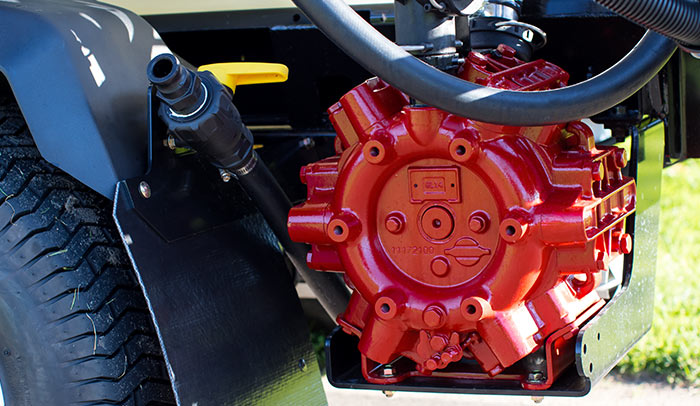This article has been updated as of July, 2024.
Toro Multi Pro® sprayers are known for their durability. But as with any machine, they require routine maintenance to make sure you’re getting the performance you need and the long service life you want.
This article will cover a general maintenance routine with an emphasis on pump maintenance.
Clean Inside And Out
The chemicals that pass through your sprayer can cause corrosion, create clogs, and damage parts, especially if left in the machine when it’s not in use. When you’re done spraying for the day, let “triple rinse” be your motto. Rinse and spray the tank out completely three times, or until the fluid runs clear. All accessories should be rinsed out as well. This will help keep debris out of the tank and ensure that you don’t mix chemicals from different applications. Triple rinse after each use and then let the pump run to be sure the lines are purged and dry.
Cleaning the outside of the sprayer is important, too. Any chemical residue can be a safety hazard for operators and can also lead to corrosion. Use a reliable cleaning product to thoroughly remove dirt and residue from the sprayer.
If you’re storing your sprayer for the winter or won’t be using it for a week or more, follow the cleaning by adding a pump conditioner or non-toxic RV antifreeze to protects the components. Put two to three gallons (7.5 to 11 liters) of pump conditioner in your sprayer and pump it through the system until it comes out of the nozzles. Then shut down your sprayer and store it with the pump conditioner left inside.

Proper
Lubrication
Your sprayer is factory greased with 10.5 oz/300 gm of grease at each
lubrication point. Over time, grease breaks down and parts need to be
re-lubricated to ensure proper performance. Toro recommends adding 1 oz/30 gm
of grease to each lubrication point after every 50 hours of normal operation.
- Use only lithium-based grease
- Be sure that your grease gun is calibrated so
that you deliver the proper amount of grease - Make sure the pump is stopped before lubricating
If your pump has been disassembled, such as for replacement of the diaphragms and/or check valves, then it must be greased with 7 oz/200 gm of grease at each lubrication point before returning to operation.
Yearly
Rebuild
An annual inspection and rebuild goes a long way toward ensuring years of
reliable sprayer operation. Under normal operating conditions, take the pump
apart once a year to inspect diaphragms and check valves for wear and cracks.
Plan to replace the valves and diaphragm every 450 hours. Your service manual
provides complete details, and for your convenience a rebuild kit with
everything you need is available through the parts catalog.

Troubleshooting
If you’re experiencing operational issues that aren’t corrected through the
routine maintenance, use this checklist* to help find the cause and solution.
ISSUE PROBABLE CAUSE (S) REMEDY
| Liquid leaks from pump bottom | Damaged diaphragm | Replace diaphragm |
| Grease leaks from pump bottom | Grease viscosity is too low | Change to recommended grease type |
| Grease leaks from the shaft grease seals | Grease viscosity is too low Worn bearings/friction too high | Change to recommended grease type Replace pump bearings and grease seals |
| Lack of pressure | Leak on the suction side of the pump Debris in the check valve and/or suction assembly Pump valves are blocked or defective Plugged filters in the fluid system | Replace any damaged parts Clean the check valve and/or suction assembly Check for obstructions and replace if needed Clean filters |
| System vibrations and unpleasant noise | Pump valves are blocked or defective Air is being sucked into the system | Check for obstructions and replace if needed Check for leaks or pinholes in suction hoses; check the fit and tightness of all gaskets and o-rings on suction-side fittings |
| Lack of flow/capacity | Internal wear on conrod and conrod ring Pump valves are blocked or defective | Poor greasing; replace parts as needed and utilize proper grease quality and intervals Check valves for obstructions and replace if needed |
| Extreme internal erosion on diaphragm covers and housing | Lack of internal cleaning Stored without pump conditioner Too high vacuum caused by plugged suction filter | Fully clean system according to instructions Always use a proper antifreeze mix during storage Clean suction filter; replace affected pump parts |
Contact your local Toro distributor if you have any questions about pump maintenance for Multi Pro sprayers.
More How-To Help
The how-to series is designed to help you get the most from your Toro equipment. If you missed any of the previous articles, just click on the titles below:
Maintaining the Ideal Quality of Cut
Extending Equipment Life With A Fuel Stabilizer
How to Choose a Rotary Blade or Bedknife
Use Service Reminders to Ensure Timely Maintenance
*Source: Hardi Pump Manual










